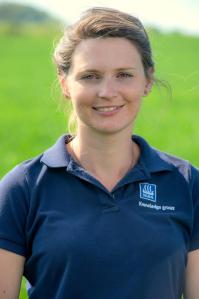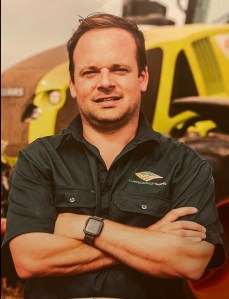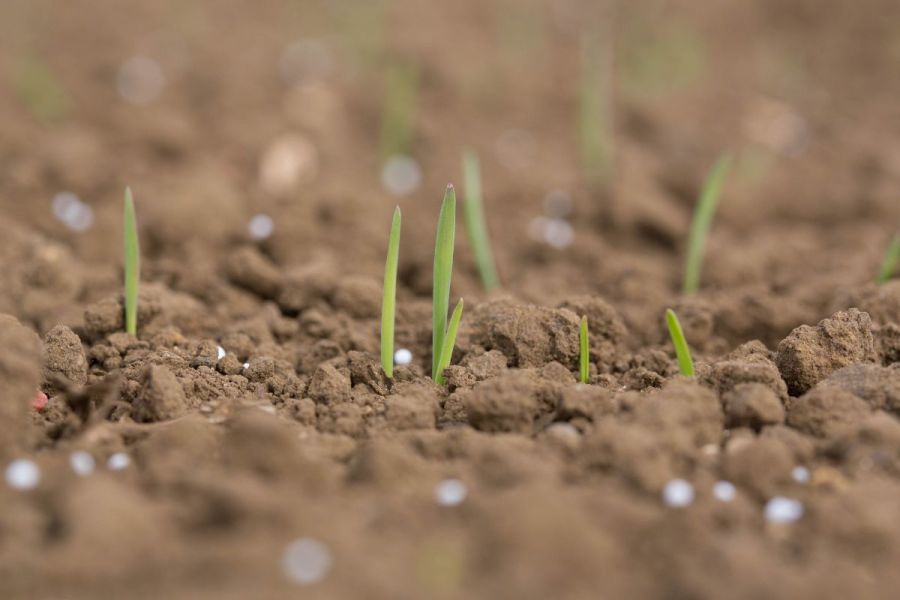The evolution of technology has revolutionised modern-day farming, but just how beneficial can it be for managing inputs? CPM explores the concept.
“It’s just about using all the tools we have, to do the best job we can.”
By Charlotte Cunningham
With input costs elevated and looking likely to stay that way for the foreseeable future, making sure every kilo of nitrogen is applied exactly when, and where, it needs to be is essential.
Precision farming technology has a role to play in this – but which tools provide the most accurate and valuable information to farmers?

Yara’s VRA platform Atfarm is free, so there’s nothing to lose by trying it and potentially a lot to gain, says Natalie Wood.
Software has found itself at the core of farm management over recent years, so it comes as no surprise that a recent survey carried out by CPM and Yara revealed that 70% of respondents use some kind of digital system – with 42% favouring Farmplan and a further 30% opting for MuddyBoots. “The more information you’ve got, the easier it is to manage your farm operations efficiently,” says Yara’s Natalie Wood.
Nottinghamshire farmer Tom Hawthorne says his management platform, Farmplan, is at the core of all decision-making. “My father was actually a beta-tester of Gatekeeper and it does what it says on the tin. We use it in quite a lot of detail – obviously for crop records, but also for stocks of inputs and outputs, as well as budgeting.”
Agronomist Ben Abell concurs and says management software is the ‘bible’ for him. “I use it for recording, stock control, accounting and so on – it’s a big part of the business for us. Having that data is essential to look back on and also justify any decision-making – both past and present. It’s also vital for crop assurance. It’s a good starting point for every single decision on the farm.”
In the field, good crop management starts with a soil test and a nutrient management plan, says Natalie and the survey showed 63% of farmers test soil every two to four years, while 26% do so annually. “Ideally, it’d be every year, though most farmers like to do it in a rotation. But however frequently you do it, the most important thing to do is be consistent.”
In terms of a nutrient management plan, she believes that RB209 is the place to start, and this is also the go-to for 66% of growers. “The data is held within AHDB and so this provides the most up-to-date results. It’s good to have some kind of thought process about how much you’ll apply in the way of nutrients, rather than just doing the same as the previous year. Last year forced a lot of people to do that purely because of the nitrogen price, but it’s a good lesson in knowing how to tailor inputs according to the historic performance of fields.”

If farmers are going to use variable rate technology, they’ve got to be completely on board with it, believes Tom Hawthorne.
Tom adds: “We use RB209 as a base and then have our own spreadsheet to build on that. We’re all using a lot more manures now. What type of manure that is and when it’s applied has a big impact on how much other nutrients will be required by the crop. As well as a huge cost, nitrogen is also a big polluter, so it’s even more important than ever to be able to justify exactly what, why and where you’re applying it. A nutrient management plan is vital.”
When it comes to fine tuning these plans and subsequent applications, technology can play an important role. With nitrogen prices at record highs of late, it’s perhaps of little surprise that 45% of growers are monitoring nitrogen uptake by their crops. “We do it quite a bit, largely to sense check what we’re doing, and also to ensure we’re maximising what we apply and minimising it when we can,” says Ben.
And what was the respondents’ tech of choice? For 39%, the Yara N-Tester is their go-to, while 24% said they opt for leaf tissue testing, and 7% are using Yara’s N Sensor.
“The elephant in the room is that nitrogen is still very expensive, so if you’re not monitoring the uptake in your crops, you don’t really know what’s in there,” says Natalie. “This means you could be putting too much on and wasting your money, or you could be putting too little on and getting less yield than you may be able to achieve. By monitoring uptake, it takes the guesswork out.”
With this in mind, she notes there has been a surge in interest for the N-Tester technology. “Essentially, the N-Tester looks at the level of chlorophyl within the crop and this directly correlates with the amount of nitrogen in the crop. From there, the tester can take that reading and calculate an application rate based on it.
“It can be used as a regular monitoring tool and some growers are using it on a weekly basis to perfect the timing of their applications. It’s very useful in terms of both saving money by taking out the guess work when it comes to nitrogen application, and it’s another way to increase your nitrogen use efficiency if you’re getting it on at the right time.”
Tom says his approach to nitrogen usage is starting off with a plan and then when it gets to the point of physically applying it, he uses the N-Tester to monitor uptake and has done for a long time. “We were also one of the original users of the N-Sensor. We now use it a bit differently and make use of an algorithm within the N-Sensor called ‘absolute mode’, which we’ve been using on oilseed rape for a long time but are now also incorporating into cereals.
“This takes away the majority of the human input when deciding how much nitrogen to apply to crops. You simply put in growth stage, what type of fertiliser you’re using and then, a bit later in the season, the crop’s yield potential. It just takes all the human emotion in decision-making away by telling you exactly what you should or shouldn’t apply. We then monitor the crop through the season to ensure we’re on track.”
Natalie agrees that this approach can help growers sense check their original nutrient plan throughout the year if circumstances change, allowing them to up nitrogen rates if necessary, for example, to ensure no yield potential is lost. “When N was £200-300/t growers probably got away with it a little bit more – inefficient applications didn’t have as big an impact. But when prices are around the £700-800/t mark then you just can’t afford to waste it.”
Regular tissue testing is also worthwhile for looking beyond just nitrogen, to help gain a better understanding of trace element levels, notes Ben. “We actually tailor our programme based on the tissue test results.”
Tying this drive for efficiency together is variable rate application technology, which 44% of growers claimed to use. In terms of their system of choice, 39% are using SOYL, compared with 16% who are using Omnia. Other systems included Yara’s Atfarm platform and xarvio. In terms of cropping, most growers (79%) said they’re using variable N rates on wheat. Of those who are using it, 93% said they trust the VRA procedures. “When you variably apply nitrogen, you’re only applying exactly what the crop needs,” says Natalie. “In terms of the physical benefits, it can help even up cropping and we see up to 4% yield increase when variable rate technology is used. This is on top of economic benefits – most people find they can save on nitrogen compared with the amount they thought they’d need to apply.”
In practice, Ben says he’s seen benefits from variable rate nitrogen application too. “It helps with problems like lodging. We’ve got some pretty fertile soil and it just means we don’t overdo it in these areas. It also helps when we get to combining as the crop is more even. For me, it’s just about using all the tools we have, to do the best job we can. I’m all for tech to help us try to be better with inputs because it adds a bit of pre-eminence to the food that we produce – that we are trying to do it smarter and more efficiently.”
However, Tom says he actually prefers to use the N-Sensor over satellite-based technology . “I’m not a huge fan of the satellite-based stuff, and it’s not always real-time. When you drive into a field with an N-Sensor, it’s in real-time and therefore I think more accurate.
“With regards to trusting the data, one of the big reasons I’m such a big fan of the N-Sensor is because of its algorithms, and all the trials work behind it to make those algorithms as good as they are,” he adds. “There is always an element of faith with these types of technology, but for me, the proof is in the pudding. If you’re going to use it, you’ve got to be completely on board with it.”
So why are 56% still not convinced? The majority of growers (72%) believe it’s essential that a variable rate application system is simple to use, while a further 66% said it has to add value for the user. “I think there’s a fear that this type of technology requires a lot of input to implement,” explains Natalie. “But these systems are really simple to use, and something like Yara’s Atfarm platform only requires inputting a few simple parameters to produce a variable rate map. What’s more, Atfarm is free – so there’s nothing to lose by trying it and potentially a lot to gain.”
At the business end of the season, 93% of growers said they monitor yield to inform decision-making the following year and, to help them with this process, 88% said they turn to their agronomist, while 35% said they use farm management software – bringing that use of technology full circle. “Knowing your yields helps to make more realistic, informed management decisions,” says Natalie. “For example, on consistently poorer performing areas, will there ever be any point in applying loads of expensive nitrogen?”
Tom says the majority of his harvested crop goes over a weighbridge, but he also tests his grain at this point to check whether the amount of nitrogen he applied was correct. “This helps us again sense check everything and inform decision making for the coming season. Sometimes at the point of application the technology might recommend different rates of nitrogen than perhaps you’d have applied, but when the results come through and you’ve got as good, or even better, yields than you’d ever had and compare this with your traditional farm practice – I can’t see why anyone wouldn’t use variable rate.”
So with fertiliser costs as high as they are and the benefits of technology well-versed, why aren’t more growers using tech tools available? Almost half (46%) believe it’s due to poor trust in data/technology, while 42% reckon it’s to do with value for money. A further 35% said it’s likely to be due to poor data integration. “There are a lot of reasons why people don’t trust the data but if you’re unsure, I think the best approach is to talk to other farmers who are using these systems and having success and even try it yourself on your own farm,” recommends Natalie.
“We’re giving our technology away for free because we want to help farmers in such difficult times, so where value for money is an issue then Atfarm is worth considering this coming season.”
Ben concludes: “Thinking more dynamically on a field-by-field basis rather than taking a whole farm approach can only be a good thing.”
Winner announcement
Congratulations to our winner Campbell Baxter from Angus, Scotland who responded to the CPM/Yara survey on managing nitrogen usage and has won the fabulous prize of an iPad Air II and an Apple pencil.
Campbell responded to the survey and completed the tie-breaker question, which asked respondents to detail, in their opinion, what would make tech products more compelling to use.
To take part in the next survey, make sure we have the correct details for you by emailing angus@cpm-magazine.co.uk
This article was taken from the latest issue of CPM. For more articles like this, subscribe here.




